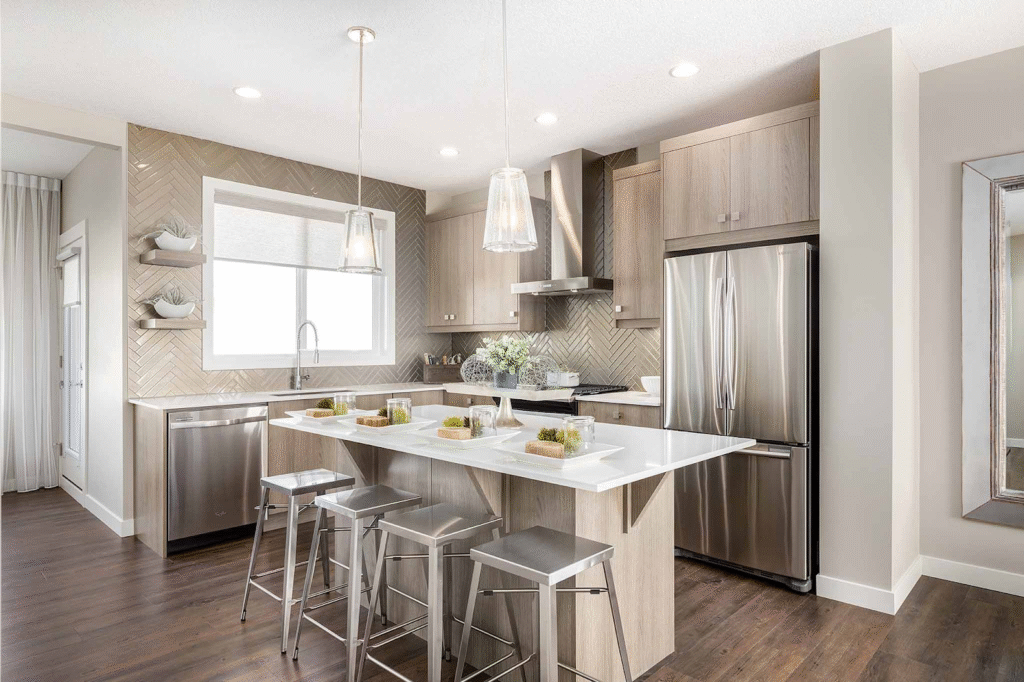Standard Kitchen Cabinet Depths
Base Cabinets
Base cabinets serve as the foundation of kitchen storage and workspace. The standard kitchen cabinet depth for base cabinets is 24 inches, measured from the front of the cabinet to the wall. This depth allows for comfortable countertop use and adequate storage for everyday kitchen essentials, including pots, pans, and dry goods. Some homeowners opt for deeper base cabinets, around 27 inches, to store larger appliances, such as mixers and blenders, while still keeping them accessible. However, increasing the depth can lead to difficulty in reaching items at the back, making pull-out shelves or drawer inserts a valuable addition.
For those who frequently use large cooking equipment, deeper base cabinets with full-extension drawers can help improve accessibility while maintaining ample storage. Additionally, incorporating dividers for lids, baking trays, and cutting boards can further optimize organization within deep-base cabinets.

Read more: Exploring the Benefits of Deep Kitchen Drawers Over Shelves
Wall Cabinets
Wall cabinets, mounted above the countertops, typically have a kitchen cabinet depth of 12 inches. This depth ensures easy access to dishes, food items, and cooking essentials while preventing obstruction of the workspace below. In modern kitchen designs, deeper wall cabinets of 15 inches are increasingly popular, offering additional storage for larger plates, bowls, and pantry items. These are particularly useful in kitchens where counter space is limited, allowing homeowners to store frequently used items within easy reach.
To enhance the functionality of wall cabinets, adjustable shelving can be added to accommodate different storage needs. Under-cabinet lighting is another great feature that improves visibility and usability, ensuring that deeper cabinets do not create dark or hard-to-reach spaces.
Tall Cabinets and Pantries
Pantry and tall utility cabinets offer extensive vertical storage. These cabinets usually have a depth of 24 inches, though some variations extend to 30 inches to accommodate bulkier items like large containers of flour, cereal boxes, and extra cookware. Choosing the right kitchen cabinet depth for pantry storage ensures ease of organization and prevents lost items at the back.
To improve accessibility, homeowners can incorporate sliding shelves, lazy Susans, or pull-out baskets, which make retrieving items from deep pantry cabinets much more convenient. Shallow pantry cabinets, around 18 inches, are sometimes preferred in smaller kitchens to balance storage needs with space efficiency. Transparent storage bins or labeled sections can also help in maintaining an organized pantry space.
How Cabinet Depth Affects Storage Capacity
Maximizing Storage Space
Deeper cabinets provide more storage space, allowing homeowners to store larger kitchen essentials, such as small appliances, large pots, and bulk food items. This is particularly useful for families who require extra pantry space or those who enjoy cooking and need additional room for utensils and cookware. However, excessively deep cabinets can lead to disorganization if not properly managed.

Read more: The Role Of Custom Cabinet Colors For Kitchens And Bathrooms
To make the most of deep cabinet storage, using pull-out trays, tiered shelving, and vertical dividers can keep items visible and easily retrievable. Stacking cookware or using modular storage systems can also enhance organization while maximizing space utilization.
Managing Accessibility
While deeper cabinets offer more storage, they can also reduce accessibility. Items at the back of deep base or pantry cabinets can be difficult to reach, leading to inefficient use of space. Shallower cabinets improve visibility and accessibility, making organization easier. A good compromise is to use deeper cabinets for long-term storage of less frequently used items and shallower cabinets for daily kitchen essentials.
Features like full-extension drawers and soft-close mechanisms further enhance usability by making stored items easier to retrieve without excessive bending or reaching. Adding pull-down shelves in upper cabinets can also improve accessibility for shorter individuals or those with mobility challenges.
Choosing the Right Depth for Your Kitchen Needs
Small Kitchen Considerations
In compact kitchens, standard or slightly reduced kitchen cabinet depth can optimize space usage. Shallow base cabinets (around 21 inches) create a more open feel while still offering storage. Wall cabinets with a depth of 10 inches can also help prevent a cramped atmosphere, allowing for more counter space and reducing the visual heaviness of the upper cabinetry.
Additionally, incorporating multi-functional storage solutions, such as under-cabinet racks, hanging organizers, or magnetic knife strips, can compensate for reduced depth while maintaining a clutter-free environment. In narrow kitchens, a combination of shallower cabinets and floating shelves can enhance both storage and aesthetics without overwhelming the space.
Large Kitchen Benefits
Larger kitchens allow for deeper base and pantry cabinets, which can accommodate specialized storage solutions like built-in spice racks, pull-out drawers, and hidden compartments. A well-thought-out cabinet depth ensures efficient use of the available space while maintaining functionality.

Read more: How To Use Kitchen Cabinet Lighting To Enhance Your Space
Homeowners with spacious kitchens may benefit from custom cabinetry that integrates multiple depths, optimizing storage without sacrificing ease of use. For example, incorporating deeper cabinets in lower sections while maintaining standard-depth wall cabinets creates a balanced and user-friendly kitchen layout. Appliance garages, built-in coffee stations, and dedicated baking storage areas can also be incorporated into deeper cabinetry for added convenience.
Balancing Aesthetics and Functionality
Visual Impact of Cabinet Depth
The depth of cabinets influences kitchen aesthetics by affecting proportions and layout. Deep cabinets in small kitchens may create a cluttered look, while appropriately sized cabinets contribute to a balanced design. Choosing the right kitchen cabinet depth ensures that the kitchen maintains an open, airy feel without compromising storage.
Glass-front cabinets, open shelving, and strategic lighting can also enhance the visual appeal of cabinets while providing additional accessibility. Light-colored cabinetry and reflective surfaces can further prevent a deep cabinet layout from making the kitchen feel too enclosed.
Customization Options
Many homeowners choose semi-custom or custom cabinetry to tailor depth according to their specific needs. Adjustable shelving, pull-out trays, and vertical dividers help maximize storage efficiency without compromising usability.

Read more: How to Finance a Kitchen Remodel: Smart Budgeting & Payment Planning
Additionally, integrating smart storage solutions such as corner pull-out units, toe-kick drawers, and appliance garages can improve functionality and make the most of every inch of cabinet depth. By customizing cabinet depth and incorporating innovative storage features, homeowners can create a kitchen that suits their unique lifestyle and cooking habits. High-tech solutions, such as motorized pull-down shelving and soft-close hinges, can further enhance the convenience of deep cabinetry.
Conclusion
The right kitchen cabinet depth ensures a functional and well-organized kitchen. While deeper cabinets provide additional storage, they must be designed with accessibility in mind. Evaluating kitchen size, storage requirements, and aesthetic preferences will help homeowners select the best cabinet depths for their space.
By understanding how depth impacts storage and usability, you can create a kitchen that is both practical and visually appealing. Whether designing a small or large kitchen, finding the ideal balance between depth, organization, and accessibility ensures a kitchen that enhances daily cooking and dining experiences. Investing in thoughtful cabinetry design will not only improve storage efficiency but also contribute to the overall comfort and usability of the kitchen space.
Fill out our form for a free consultation, or you can give us a call at (587) 817-5182. Our team at Zen Living Kitchen & Bath is eager to work with you and hear all about your project ideas. We are dedicated to turning your vision into a reality.






